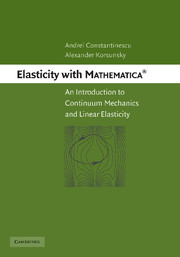Book contents
- Frontmatter
- Contents
- Acknowledgments
- Introduction
- 1 Kinematics: displacements and strains
- 2 Dynamics and statics: stresses and equilibrium
- 3 Linear elasticity
- 4 General principles in problems of elasticity
- 5 Stress functions
- 6 Displacement potentials
- 7 Energy principles and variational formulations
- Appendix 1 Differential operators
- Appendix 2 MATHEMATICA® tricks
- Appendix 3 Plotting parametric meshes
- Bibliography
- Index
3 - Linear elasticity
Published online by Cambridge University Press: 11 November 2009
- Frontmatter
- Contents
- Acknowledgments
- Introduction
- 1 Kinematics: displacements and strains
- 2 Dynamics and statics: stresses and equilibrium
- 3 Linear elasticity
- 4 General principles in problems of elasticity
- 5 Stress functions
- 6 Displacement potentials
- 7 Energy principles and variational formulations
- Appendix 1 Differential operators
- Appendix 2 MATHEMATICA® tricks
- Appendix 3 Plotting parametric meshes
- Bibliography
- Index
Summary
OUTLINE
In the preceding chapters we have discussed, on the one hand, the kinematics of deformation of continuous media, where the principal unknowns are the displacement vector field u and the strain tensor field ∊. On the other hand, we have introduced the dynamics of deformation, representing the balance of forces in terms of the stress tensor field σ as the principal unknown.
Until now we have made no attempt to relate the strain and stress fields to each other. Before we begin the discussion of the detailed nature of this relationship, we can make the following general remarks:
Description so far is clearly incomplete, because we have at our disposal only 6 kinematic relations and 3 force balance equations for the determination of the 3 + 6 + 6 unknown functions, that is, the components of displacement u, strain ∊, and stress σ.
We are so far unable to distinguish between different materials which might assume different deformed configurations under the same external loading. Clearly structures produced out of wood, steel, or ceramic may deform in different ways, so that the complete solutions are different.
The purpose of this chapter is to establish a class of relationships between strains and stresses known as the linear elastic constitutive law and to discuss a series of basic properties of these relationships.
- Type
- Chapter
- Information
- Elasticity with Mathematica ®An Introduction to Continuum Mechanics and Linear Elasticity, pp. 56 - 85Publisher: Cambridge University PressPrint publication year: 2007



